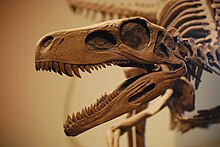Herrerasauridae
| Herrerasauridae Temporal range: Late Triassic, 231.4–225 Ma |
|
|---|---|
 |
|
| Mounted Herrerasaurus ischigualastensis skeleton cast, at the Field Museum in Chicago | |
| Scientific classification | |
| Kingdom: | Animalia |
| Phylum: | Chordata |
| Class: | Reptilia |
| Clade: | Dinosauria |
| Order: | Saurischia |
| Family: |
†Herrerasauridae Reig, 1963 |
| Genera | |
| Synonyms | |
|
|
Herrerasaurids are among the oldest known dinosaurs, appearing in the fossil record 231.4 million years ago (Late Triassic). These dinosaurs became extinct by the end of the Triassic period. Herrerasaurids were small-sized (not more than 4 metres (13 ft) long) carnivorous basal saurischians. The best known representatives of this group are from South America (Brazil, Argentina), where they were first discovered in the 1960s. A nearly complete skeleton of Herrerasaurus ischigulastensis was discovered in the Ischigualasto Formation in San Juan, Argentina, in 1988. Less complete herrerasaurids have been found in North America, and they may have inhabited other continents as well.
Herrerasaurid anatomy is unusual and specialized, and they are not considered to be ancestral to any later dinosaur group. They only superficially resemble theropods and often present a mixture of very primitive and derived traits. The acetabulum is only partly open, and there are only two sacral vertebrae, the lowest number among dinosaurs. The pubic bone has a derived structure, being rotated somewhat posteriorly and folded to create a superficially tetanuran-like terminal expansion, especially prominent in H. ischigulastensis. The hand is primitive in having five metacarpals and the third finger longer than the second, but clearly theropod in having only three long fingers, with curved claws. Herrerasaurids also have a hinged mandible, which is also found in theropods.
...
Wikipedia
